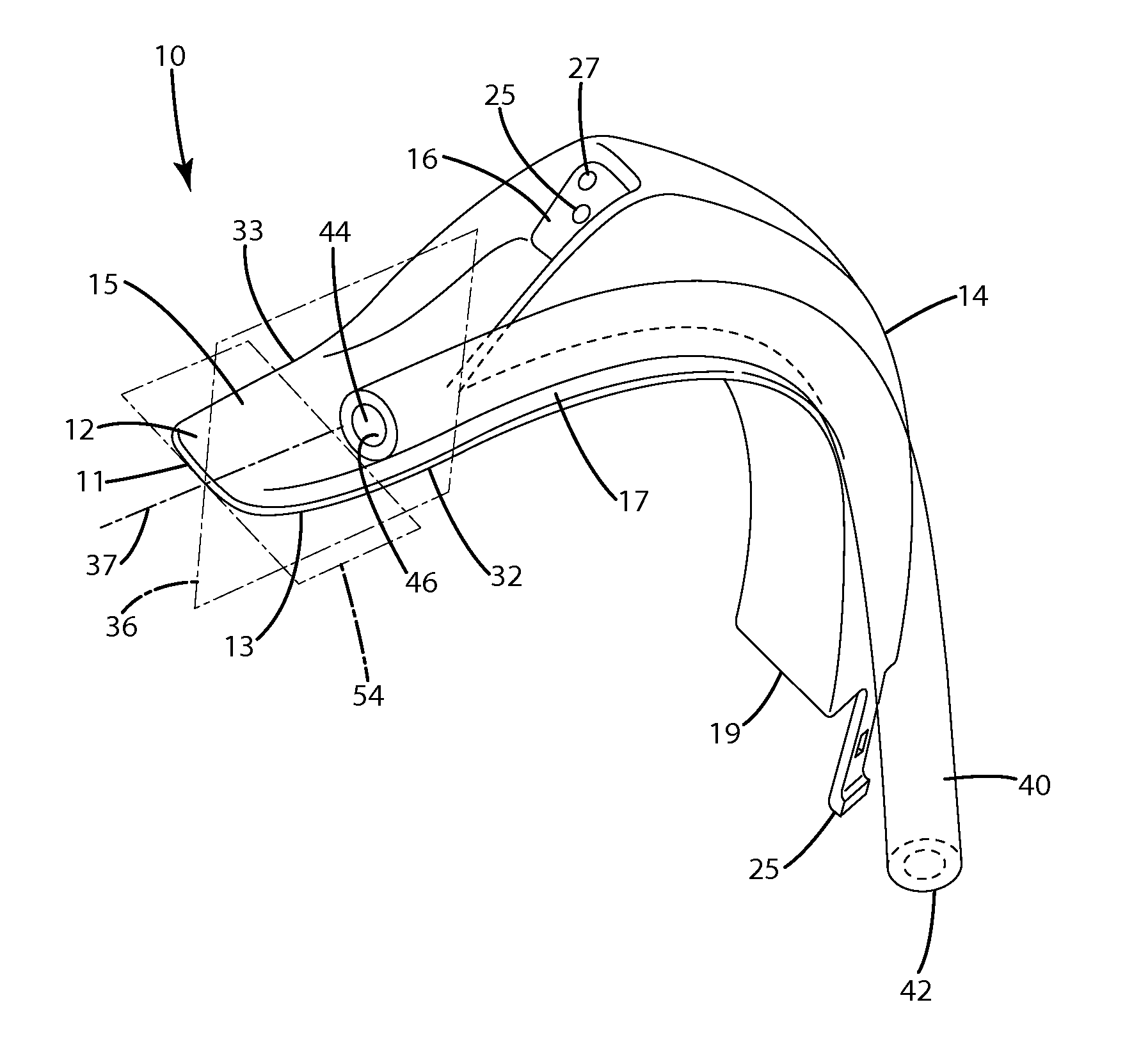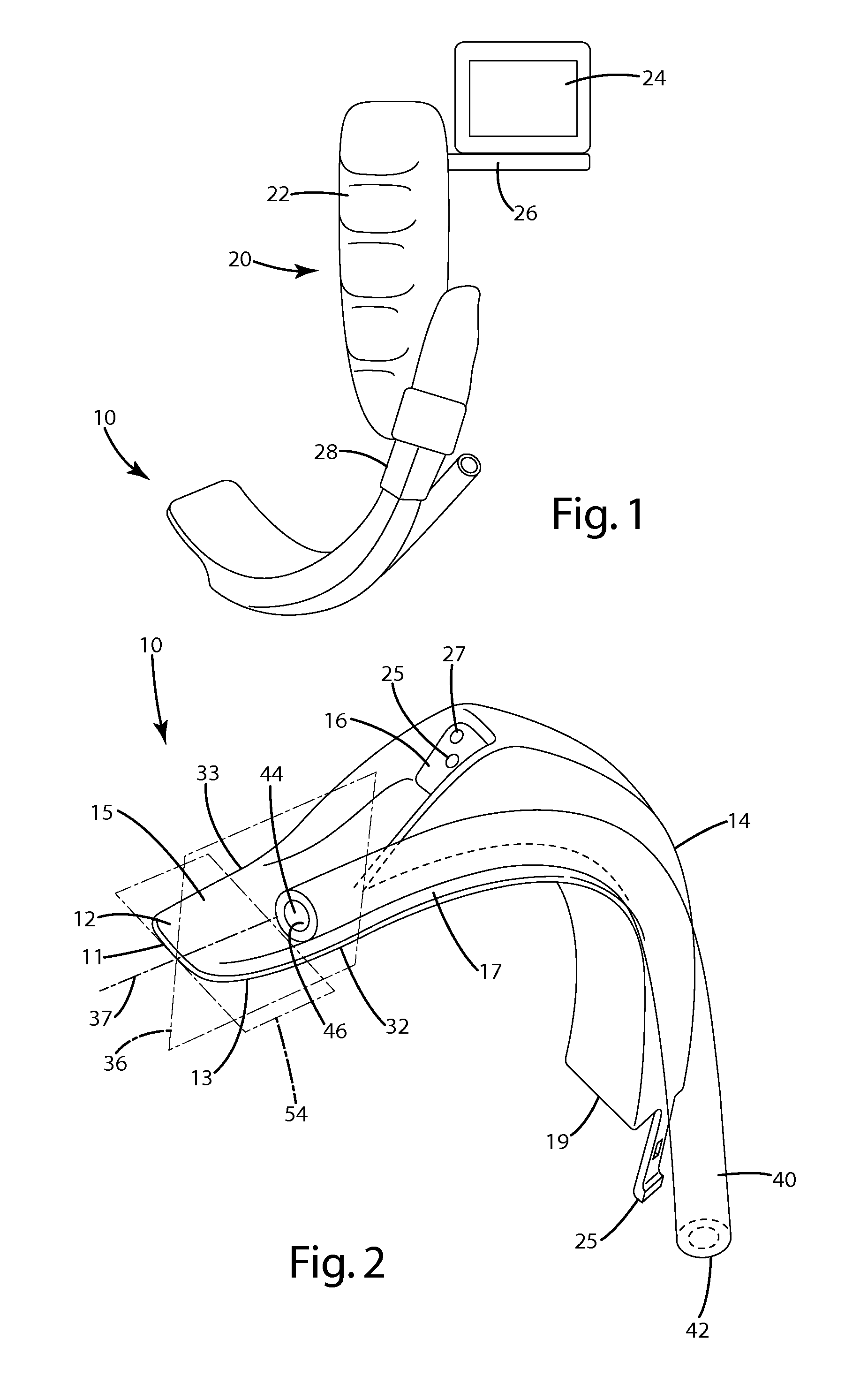Laryngoscope guide and related method of use
a technology of laryngoscope and guide, which is applied in the field of medical devices, can solve the problems of difficulty if not impossible to use on subjects, unintentionally abrade or agitate tissue in the region where it is blind, and get hung up, so as to speed up the time to intubation and speed up the treatment. the effect of tim
- Summary
- Abstract
- Description
- Claims
- Application Information
AI Technical Summary
Benefits of technology
Problems solved by technology
Method used
Image
Examples
first alternative embodiment
III. First Alternative Embodiment
[0120]A first alternative embodiment of the laryngoscope guide is illustrated in FIG. 8 and generally designated 1010. The laryngoscope guide 1010 in this embodiment is similar to the current embodiment, with several exceptions. For example, the optical axis 1025A projects from the imaging system 1025 substantially parallel to the first blade plane 1036 and / or the midline 1037. Optionally, it may diverge from these reference elements. The advancement axis 1052 is aligned to intersect the first blade plane 1036 at the point of intersection 1051B. This point of intersection can be forward of the blade tip 1011 a distance as described in the embodiments above. Likewise, the advancement axis 1052 is aligned to traverse the midline 1037. The advancement axis 1052 can be oriented at angles similar to γ noted above in connection with the first embodiment shown in FIG. 7. Further, the advancement axis 1052 can be aligned to traverse the optical axis 1025A. T...
second alternative embodiment
IV. Second Alternative Embodiment
[0121]A second alternative embodiment of the laryngoscope guide is illustrated in FIG. 9 and generally designated 2010. This laryngoscope guide 2010 is similar to the above embodiments with several exceptions. For example, in this embodiment, the advancement axis 2052 is generally parallel to and / or diverges from the blade plane 2036, or generally does not traverse the midline 2037 forward of the distal tip 2011 of the blade 2012. The advancement axis 2052 can, however, be aligned so that it traverses the optical axis 2025A if desired. This traversing can occur at some point 2051A forward of the distal tip 2011 of the blade 2012. Of course, if desired, the point of traverse can occur rearward of the distal tip 2011, as with any of the embodiments herein.
[0122]The advancement axis 2052 and optical axis 2025A can be disposed relative to one another at angles similar to the angle Ψ described in the current embodiment above. The optical axis 2025A also c...
third alternative embodiment
V. Third Alternative Embodiment
[0124]A third alternative embodiment of the laryngoscope guide is illustrated in FIG. 10 and generally designated 3010. This laryngoscope guide 3010 is similar to the above embodiments with several exceptions. For example, in this embodiment, the guide conduit 3040 is positioned generally centrally relative to the blade 3012 of the guide 3010. Accordingly, the advancement axis 3052 is aligned with the first blade plane 3036 so that it is coincident with the first blade plane 3036. Optionally, the advancement axis 3052 can run parallel to the plane 3036. The axis 3052 also can be parallel to, and generally lay above the midline 3037.
[0125]The optical axis 3025A and advancement axis 3052 can intersect at some point 3051A forward of the distal tip 3011 of the blade 3012. Of course in the embodiment illustrated in FIG. 10, the first blade plane 3036 and optionally the midline 3037 can also intersect or traverse the optical axis 3025A at the location 3051A ...
PUM
 Login to View More
Login to View More Abstract
Description
Claims
Application Information
 Login to View More
Login to View More - R&D
- Intellectual Property
- Life Sciences
- Materials
- Tech Scout
- Unparalleled Data Quality
- Higher Quality Content
- 60% Fewer Hallucinations
Browse by: Latest US Patents, China's latest patents, Technical Efficacy Thesaurus, Application Domain, Technology Topic, Popular Technical Reports.
© 2025 PatSnap. All rights reserved.Legal|Privacy policy|Modern Slavery Act Transparency Statement|Sitemap|About US| Contact US: help@patsnap.com



